Solar Spectral Beam Splitting Simulation of Aluminum-Based Nanofluid Compatible with Photovoltaic Cells
Abstract
1. Introduction
2. Numerical Simulation
2.1. Calculation Method and Physical Model
2.2. Model Validation
3. Results and Discussion
3.1. Effect of Particle Size on Extinction Characteristics of Al Nanoparticles
3.2. Effect of Core–Shell Structure on Extinction Characteristics of Nanoparticles
3.3. The Spectral Properties of Nanofluids
4. Conclusions
- (1)
- Changing the particle size enables the modulation of the extinction properties of nanoparticles, including extinction intensity and resonance peak range. Al nanoparticles with particle sizes of 50 nm and 60 nm have improved extinction in the photothermal window (200–640 nm).
- (2)
- The Al@Ag core–shell nanoparticle design effectively addresses the issue of rapid oxidation of pure Al nanoparticles in ambient conditions. Moreover, coating Al with a thin Ag shell significantly enhances extinction efficiency in the short-wavelength range (350–640 nm).
- (3)
- After dispersing Al nanoparticles into water to form a nanofluid, the transmittance in the short-wavelength range is significantly reduced compared to pure water. Compared to 50 nm pure Al particles, the Al@Ag nanofluid further reduces the transmittance by up to 13% in the wavelength range of 350–650 nm, while having almost no impact on the transmittance in the photovoltaic window (640–1080 nm).
Author Contributions
Funding
Data Availability Statement
Conflicts of Interest
References
- Xu, Y.; Wu, S.; Li, Y. Research Progress of CaO-CO2 Thermochemical Heat Storage Technology for Concentrated Solar Power Plant. Power Gener. Technol. 2022, 43, 740–747. [Google Scholar]
- Li, Y.F.; Zhang, T.; Zhang, H.; Cui, P.; Fu, Z.; Gao, Z.; Geng, Q.; Liu, Z.; Zhu, Q.; Li, H.; et al. Efficient and Comprehensive Photovoltaic/Photothermal Utilization Technologies for Solar Energy. Power Gener. Technol. 2022, 43, 373–391. [Google Scholar]
- Makki, A.; Omer, S.; Sabir, H. Advancements in hybrid photovoltaic systems for enhanced solar cells performance. Renew. Sustain. Energy Rev. 2015, 41, 658–684. [Google Scholar] [CrossRef]
- Ju, X.; Xu, C.; Han, X.; Du, X.; Wei, G.; Yang, Y. A review of the concentrated photovoltaic/thermal (CPVT) hybrid solar systems based on the spectral beam splitting technology. Appl. Energy 2017, 187, 534–563. [Google Scholar] [CrossRef]
- Mojiri, A.; Taylor, R.; Thomsen, E.; Rosengarten, G. Spectral beam splitting for efficient conversion of solar energy—A review. Renew. Sustain. Energy Rev. 2013, 28, 654–663. [Google Scholar] [CrossRef]
- Brekke, N.; Dale, J.; DeJarnette, D.; Hari, P.; Orosz, M.; Roberts, K.; Tunkara, E.; Otanicar, T. Detailed performance model of a hybrid photovoltaic/thermal system utilizing selective spectral nanofluid absorption. Renew. Energy 2018, 123, 683–693. [Google Scholar] [CrossRef]
- Xiao, Y.; Niu, W.Z.; Wei, G.S.; Cui, L.; Du, X.Z. Review on Research Status and Developing Tendency of Solar Photovoltaic/Thermal Technology. Power Gener. Technol. 2022, 43, 392–404. [Google Scholar]
- Joshi, S.S.; Dhoble, A.S.; Sathe, T.; Mangrulkar, C. Performance Analysis of Photovoltaic Thermal System Using Silicone Oil Spectrum Filter. Appl. Sol. Energy 2018, 54, 4–9. [Google Scholar] [CrossRef]
- Imenes, A.G.; Mills, D.R. Spectral beam splitting technology for increased conversion efficiency in solar concentrating systems: A review. Sol. Energy Mater. Sol. Cells 2004, 84, 19–69. [Google Scholar] [CrossRef]
- Crisostomo, F.; Taylor, R.A.; Zhang, T.; Perez-Wurfl, I.; Rosengarten, G.; Everett, V.; Hawkes, E.R. Experimental testing of SiNx/SiO2 thin film filters for a concentrating solar hybrid PV/T collector. Renew. Energy 2014, 72, 79–87. [Google Scholar] [CrossRef]
- Jiang, S.; Hu, P.; Mo, S.; Chen, Z. Optical modeling for a two-stage parabolic trough concentrating photovoltaic/thermal system using spectral beam splitting technology. Sol. Energy Mater. Sol. Cells 2010, 94, 1686–1696. [Google Scholar] [CrossRef]
- Chauhan, A.; Tyagi, V.V.; Anand, S. Futuristic approach for thermal management in solar PV/thermal systems with possible applications. Energy Convers. Manag. 2018, 163, 314–354. [Google Scholar] [CrossRef]
- Rosa-Clot, M.; Rosa-Clot, P.; Tina, G.M.; Ventura, C. Experimental photovoltaic-thermal Power Plants based on TESPI panel. Sol. Energy 2016, 133, 305–314. [Google Scholar] [CrossRef]
- Joshi, S.S.; Dhoble, A.S.; Jiwanapurkar, P.R. Investigations of Different Liquid Based Spectrum Beam Splitters for Combined Solar Photovoltaic Thermal Systems. J. Sol. Energy Eng. 2016, 138, 021003. [Google Scholar] [CrossRef]
- Looser, R.; Vivar, M.; Everett, V. Spectral characterisation and long-term performance analysis of various commercial Heat Transfer Fluids (HTF) as Direct-Absorption Filters for CPV-T beam-splitting applications. Appl. Energy 2014, 113, 1496–1511. [Google Scholar] [CrossRef]
- Ahmad, T.; Wani, I.A.; Ahmed, J.; Al-Hartomy, O.A. Effect of gold ion concentration on size and properties of gold nanoparticles in TritonX-100 based inverse microemulsions. Appl. Nanosci. 2014, 4, 491–498. [Google Scholar] [CrossRef]
- Wang, T.; Tang, G.H. Theoretical and Experimental Study on the Extinction Properties of Silver Nanoparticles. J. Eng. Thermophys. 2019, 40, 639–643. [Google Scholar]
- Rycenga, M.; Cobley, C.M.; Zeng, J.; Li, W.; Moran, C.H.; Zhang, Q.; Qin, D.; Xia, Y. Controlling the Synthesis and Assembly of Silver Nanostructures for Plasmonic Applications. Chem. Rev. 2011, 111, 3669–3712. [Google Scholar] [CrossRef]
- Nyabadza, A.; McCarthy, É.; Makhesana, M.; Heidarinassab, S.; Azoulay-Younes, L.; O’Toole, K.; Vazquez, M.; Brabazon, D. A review of carbon and aluminium nanofluids and elastocaloric materials for heating and cooling applications. Int. J. Thermofluids 2025, 27, 101–163. [Google Scholar] [CrossRef]
- Zacarías, A.; de Vega, M.; García-Hernando, N.; Venegas, M. Aqueous Theta-Phase Aluminum Oxide Nanofluid for Energy Applications: Experimental Study on Thermal Conductivity. Appl. Sci. 2024, 14, 3225. [Google Scholar] [CrossRef]
- Zhang, Q.; Li, W.; Moran, C.; Zeng, J.; Chen, J.; Wen, L.-P.; Xia, Y. Seed-Mediated Synthesis of Ag Nanocubes with Controllable Edge Lengths in the Range of 30−200 nm and Comparison of Their Optical Properties. J. Am. Chem. Soc. 2010, 132, 11372–11378. [Google Scholar] [CrossRef]
- Han, X.; Chen, X.; Wang, Q.; Alelyani, S.M.; Qu, J. Investigation of CoSO4-based Ag nanofluids as spectral beam splitters for hybrid PV/T applications. Sol. Energy 2019, 177, 387–394. [Google Scholar] [CrossRef]
- Wang, G.; Chen, X.; Lin, J.; Xu, C.; Ju, X. Experimental study on a concentrating solar photovoltaic/thermal system using different fluid spectral beam filters. J. Clean. Prod. 2023, 429, 139549. [Google Scholar] [CrossRef]
- Saroha, S.; Mittal, T.; Modi, P.J.; Bhalla, V.; Khullar, V.; Tyagi, H.; Taylor, R.A.; Otanicar, T.P. Theoretical Analysis and Testing of Nanofluids-Based Solar Photovoltaic/Thermal Hybrid Collector. J. Heat Transf. 2015, 137, 091015. [Google Scholar] [CrossRef]
- Abdelrazik, A.S.; Al-Sulaiman, F.A.; Saidur, R. Optical behavior of a water/silver nanofluid and their influence on the performance of a photovoltaic-thermal collector. Sol. Energy Mater. Sol. Cells 2019, 201, 110054. [Google Scholar] [CrossRef]
- Abdelrazik, A.S.; Tan, K.H.; Aslfattahi, N.; Saidur, R.; Al-Sulaiman, F.A. Optical properties and stability of water-based nanofluids mixed with reduced graphene oxide decorated with silver and energy performance investigation in hybrid photovoltaic/thermal solar systems. Int. J. Energy Res. 2020, 44, 11487–11508. [Google Scholar] [CrossRef]
- Bhatia, P.; Verma, S.S.; Sinha, M.M. Optical absorption analysis of core-shell type Ni@Ag/Au & NiFe@Ag/Au magneto-plasmonic nanostructures. J. Quant. Spectrosc. Radiat. Transf. 2021, 268, 107646. [Google Scholar]
- Wang, Q.; Yang, L.; Zhao, N.; Xu, G.; Song, J.; Jin, X.; Li, X.; Liu, S. A review of applications of plasmonic and conventional nanofluids in solar heat collection. Appl. Therm. Eng. 2023, 219, 119476. [Google Scholar] [CrossRef]
- Taflove, A.; Brodwin, M.E. Numerical Solution of Steady-State Electromagnetic Scattering Problems Using the Time-Dependent Maxwell’s Equations. IEEE Trans. Microw. Theory Tech. 1975, 23, 623–630. [Google Scholar] [CrossRef]
- Liu, Y.; Sun, G.; Wu, D.; Dong, S. Investigation on the correlation between solar absorption and the size of non-metallic nanoparticles. J. Nanoparticle Res. 2019, 21, 161. [Google Scholar] [CrossRef]
- Hong, W.P.; Lan, J.R.; Li, H.R.; Li, B.Y.; Niu, X.J.; Li, Y. Reversal Behavior of Optical Absorption Rate of Bimetallic Core-Shell Nanoparticles Based on Finite-Difference Time-Domain Method. Acta Phys. Sin. 2021, 70, 207801. [Google Scholar] [CrossRef]
- Gedney, S.D. An anisotropic perfectly matched layer-absorbing medium for the truncation of FDTD lattices. IEEE Trans. Antennas Propag. 1996, 44, 1630–1639. [Google Scholar] [CrossRef]
- Chen, X.; Zhou, P.; Chen, M. Enhancing the solar absorption performance of nanoparticle suspensions by tuning the scattering effect and incident light location. Int. J. Therm. Sci. 2022, 177, 107547. [Google Scholar] [CrossRef]
- Galy, T.; Huang, D.; Pilon, L. Revisiting independent versus dependent scattering regimes in suspensions or aggregates of spherical particles. J. Quant. Spectrosc. Radiat. Transf. 2020, 246, 106924. [Google Scholar] [CrossRef]
- Weber, M.J. Handbook of Optical Materials, 1st ed.; CRC Press: Boca Raton, FL, USA, 2002. [Google Scholar]
- Huang, J.; Han, X.; Zhao, X.; Khosa, A.A.; Meng, C. The stability, optical behavior optimization of Ag@SiO2 nanofluids and their application in spectral splitting photovoltaic/thermal receivers. Renew. Energy 2022, 190, 865–878. [Google Scholar] [CrossRef]

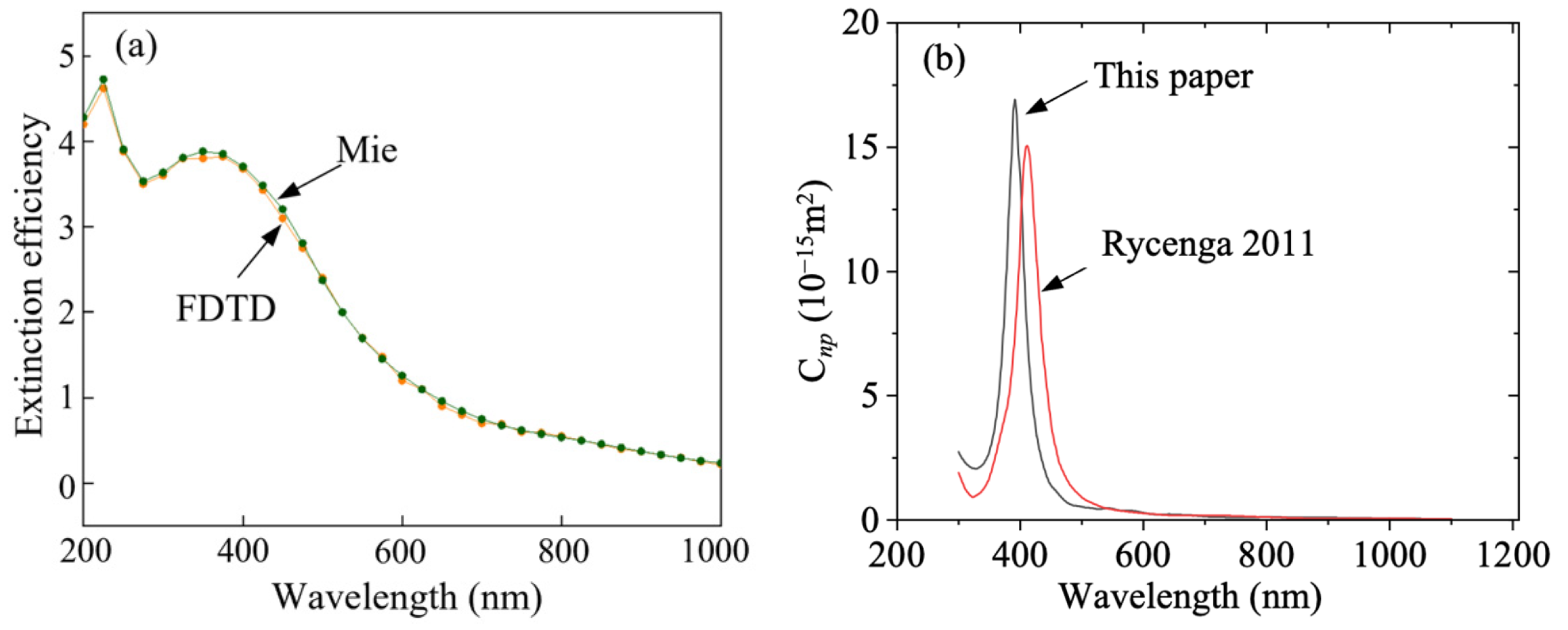
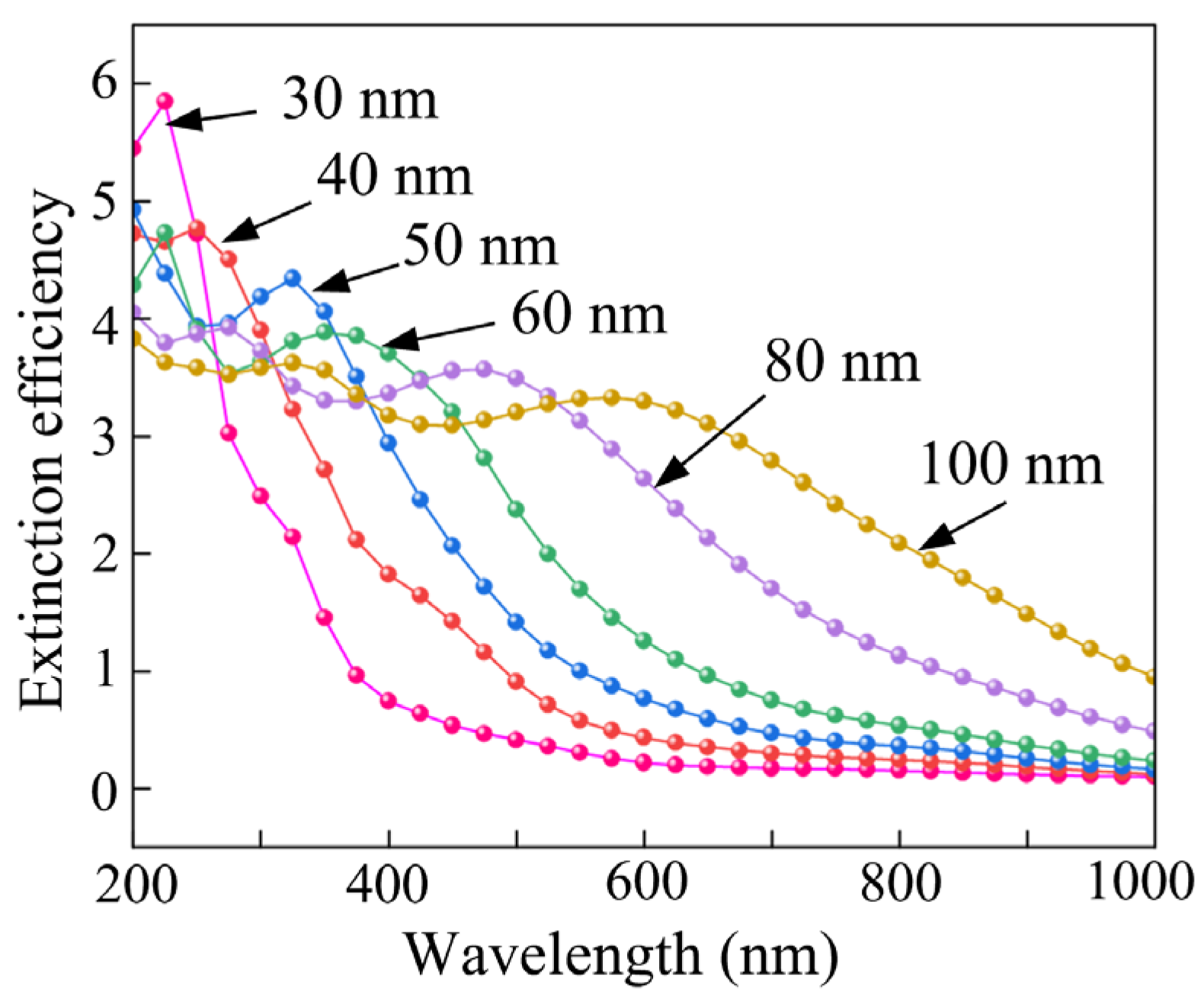
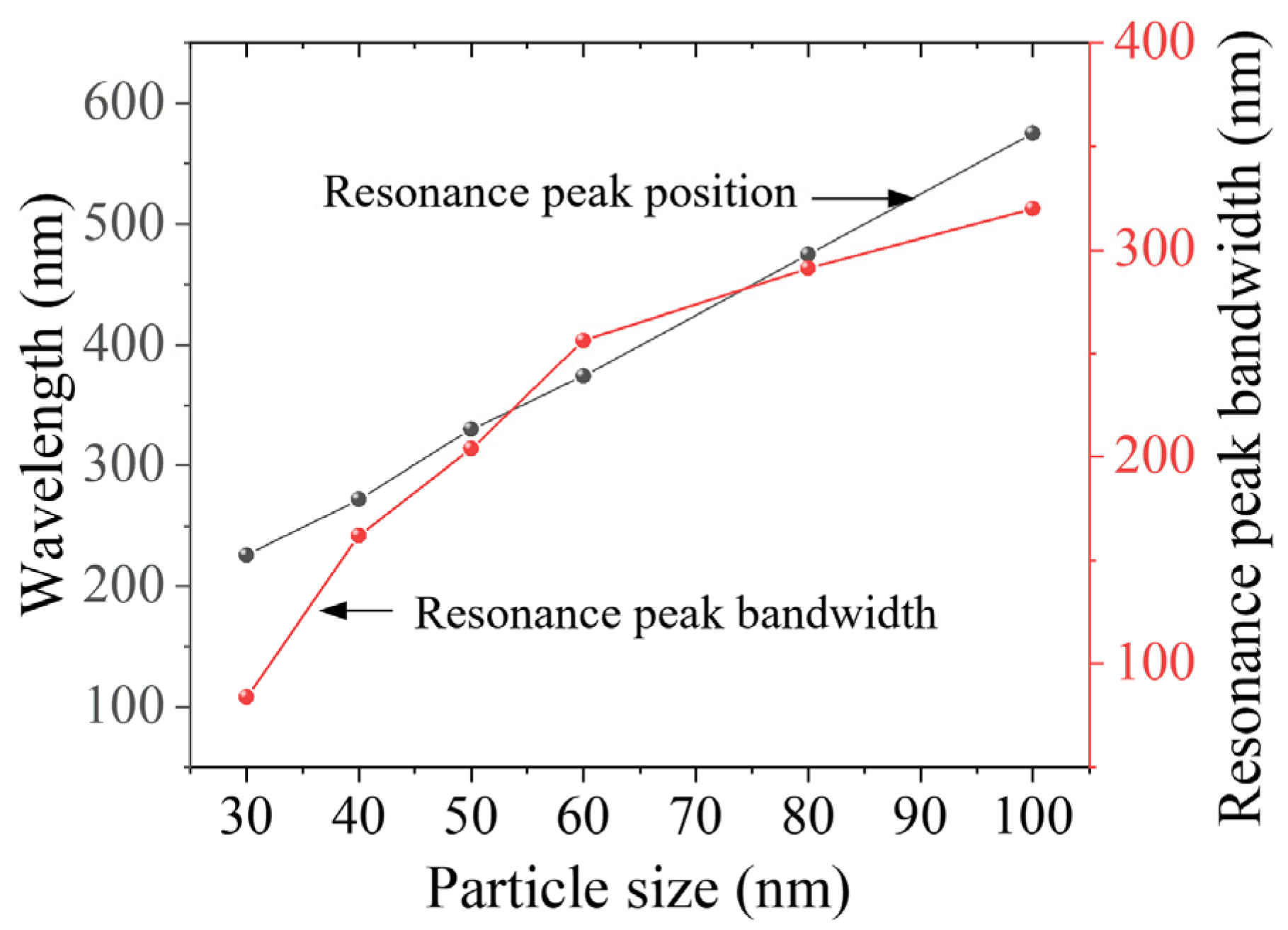
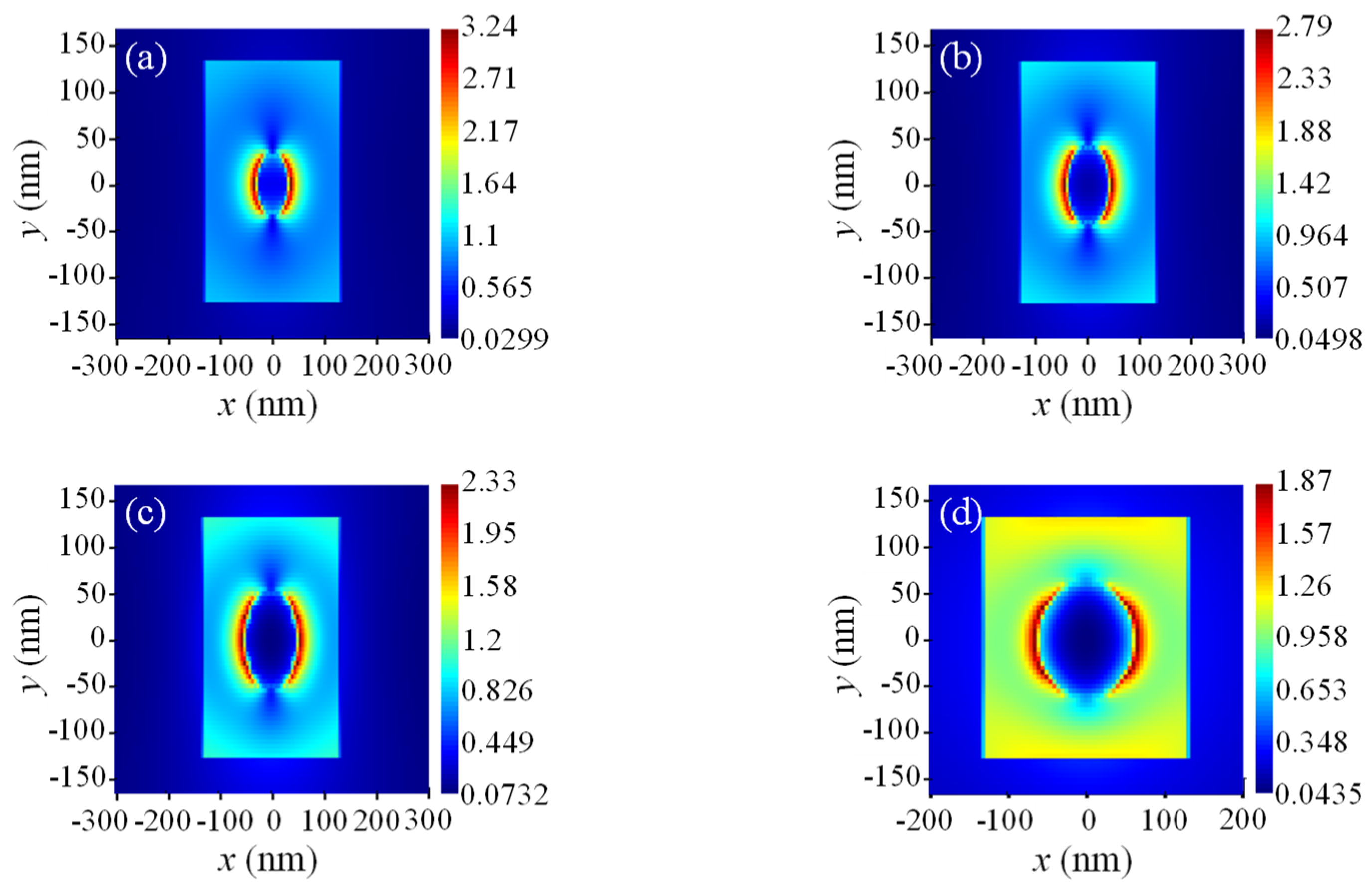
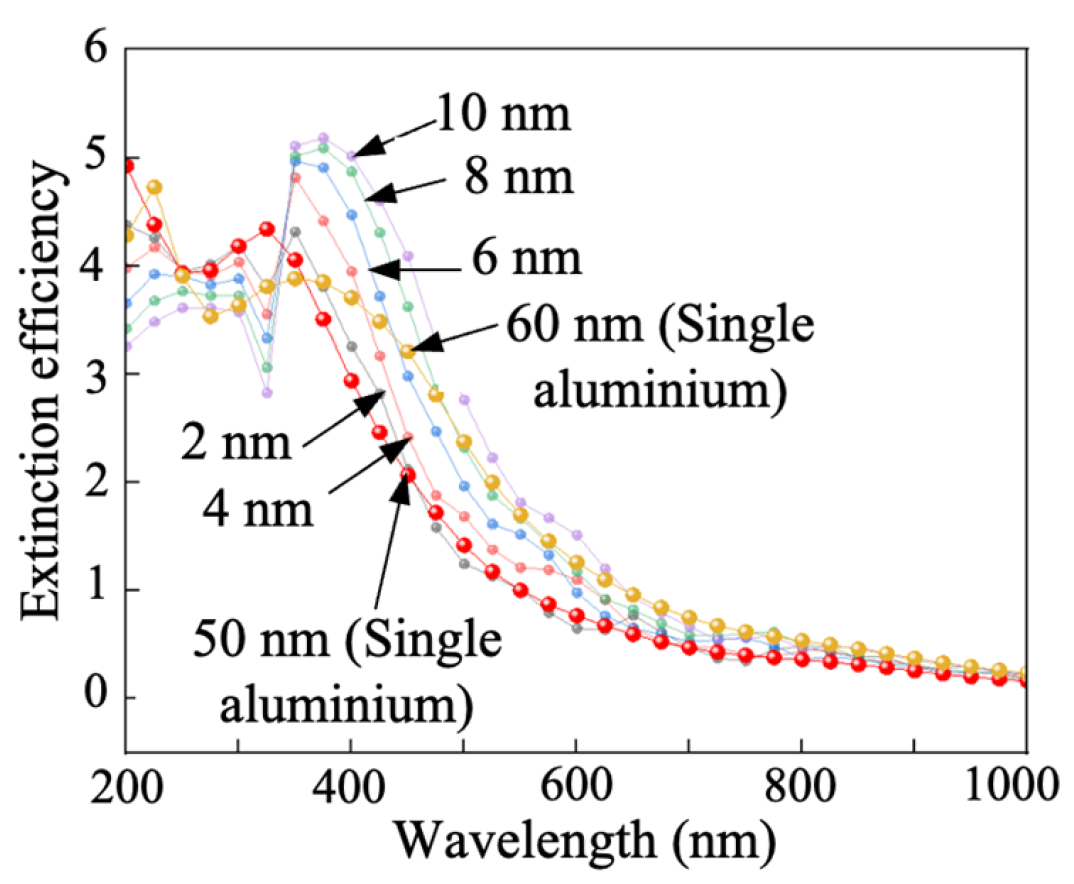
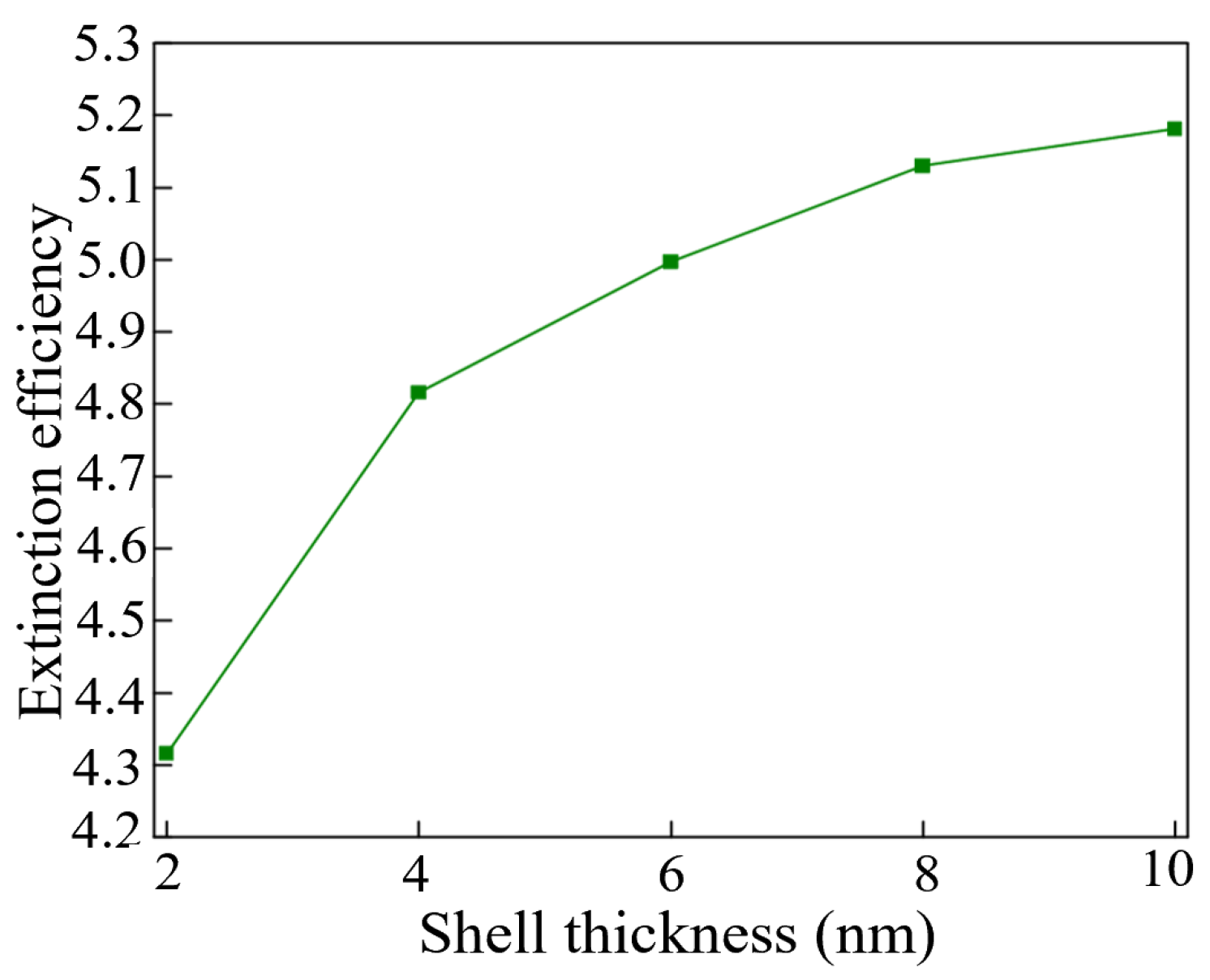
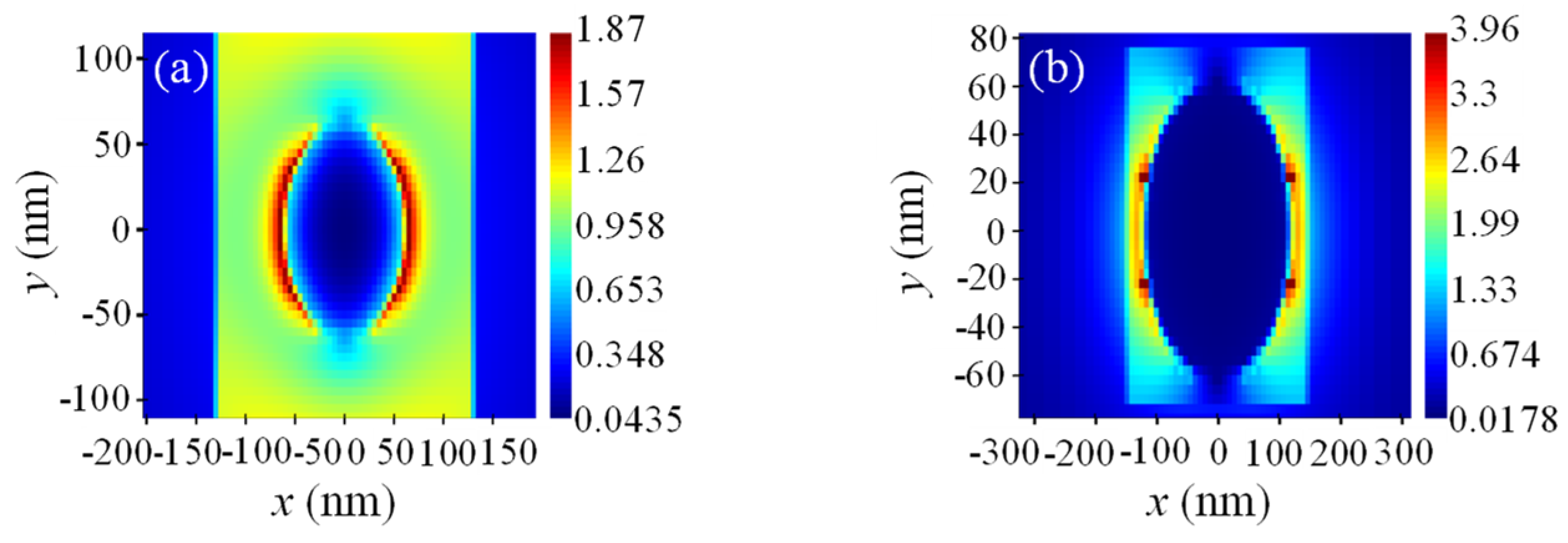
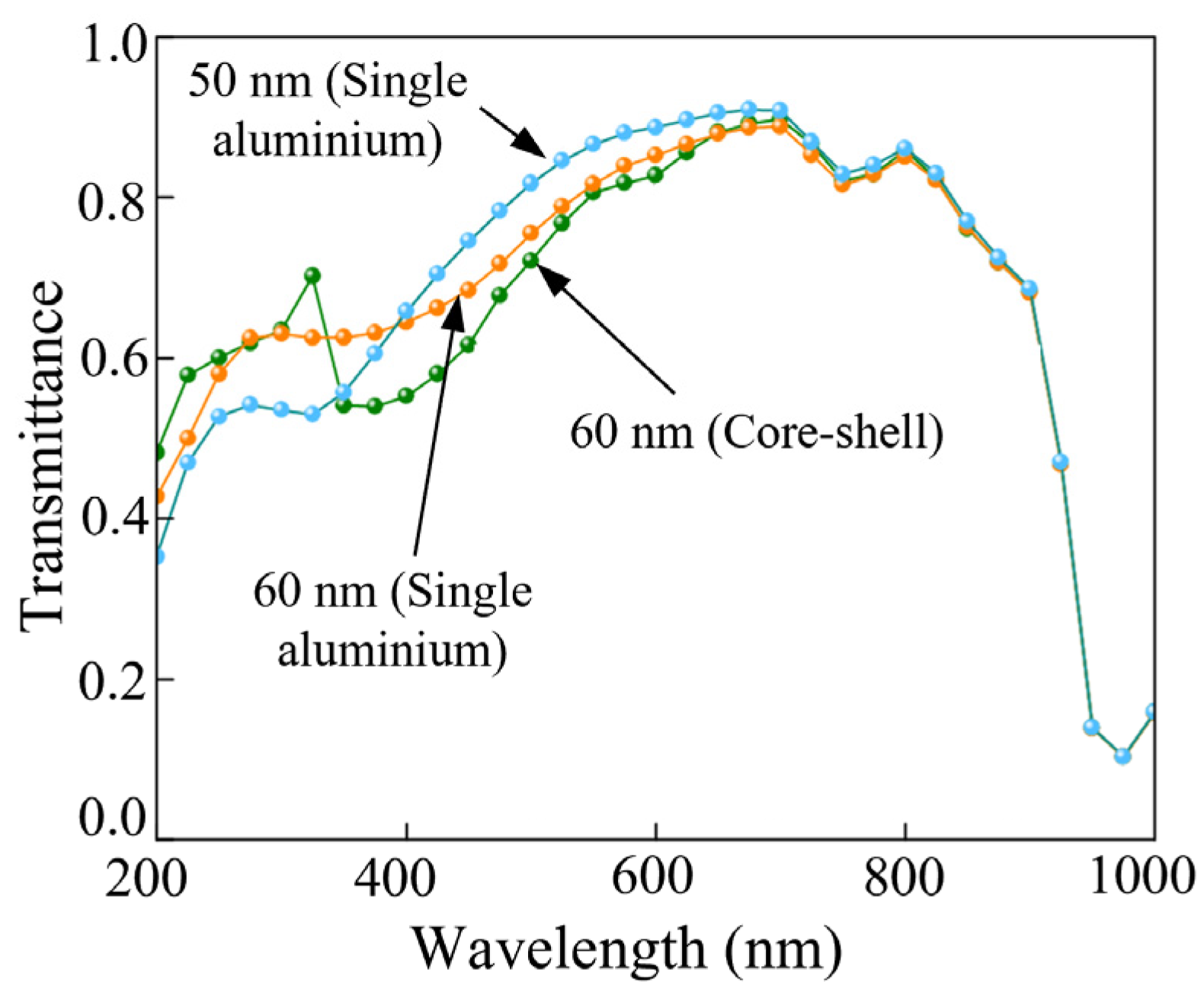
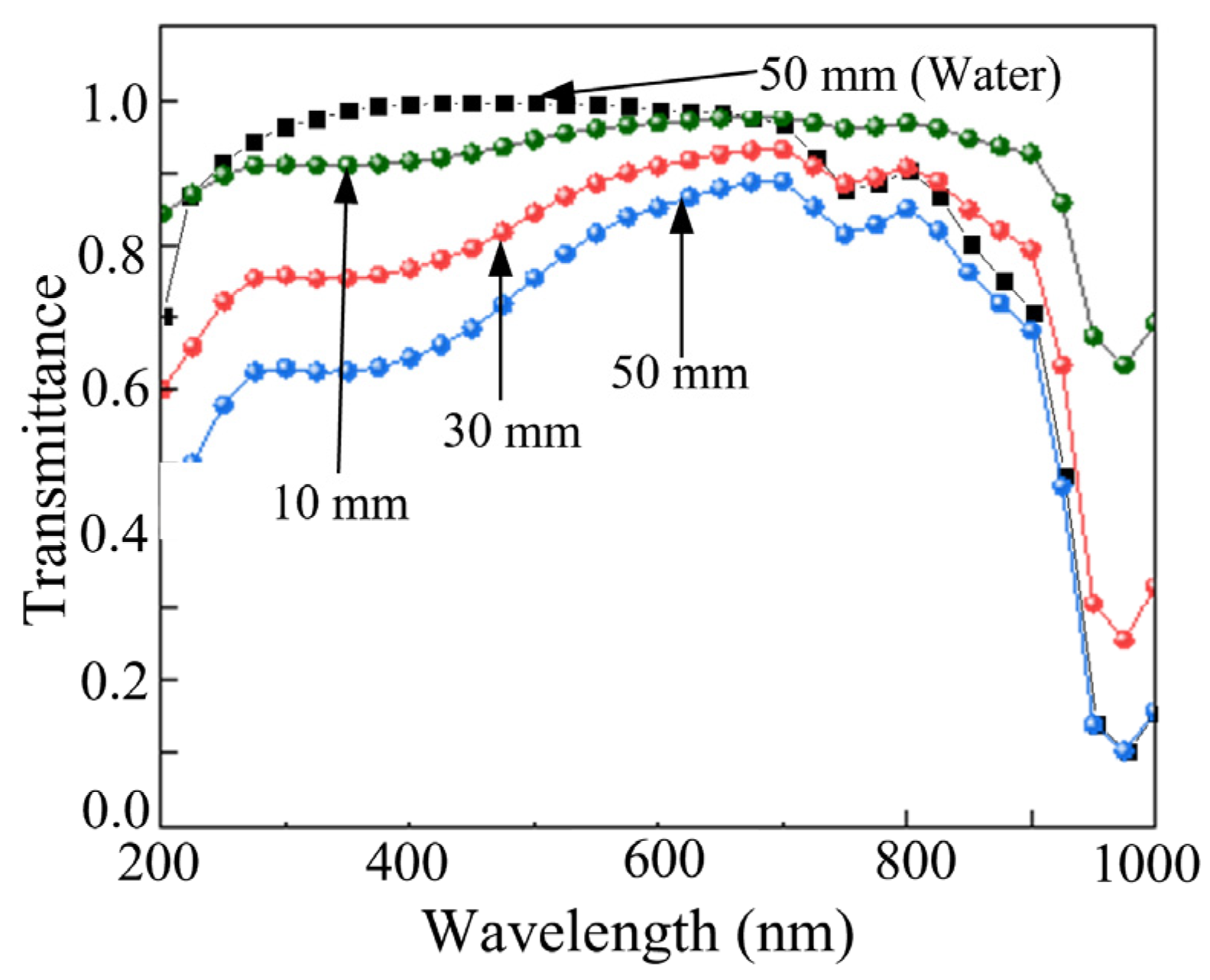
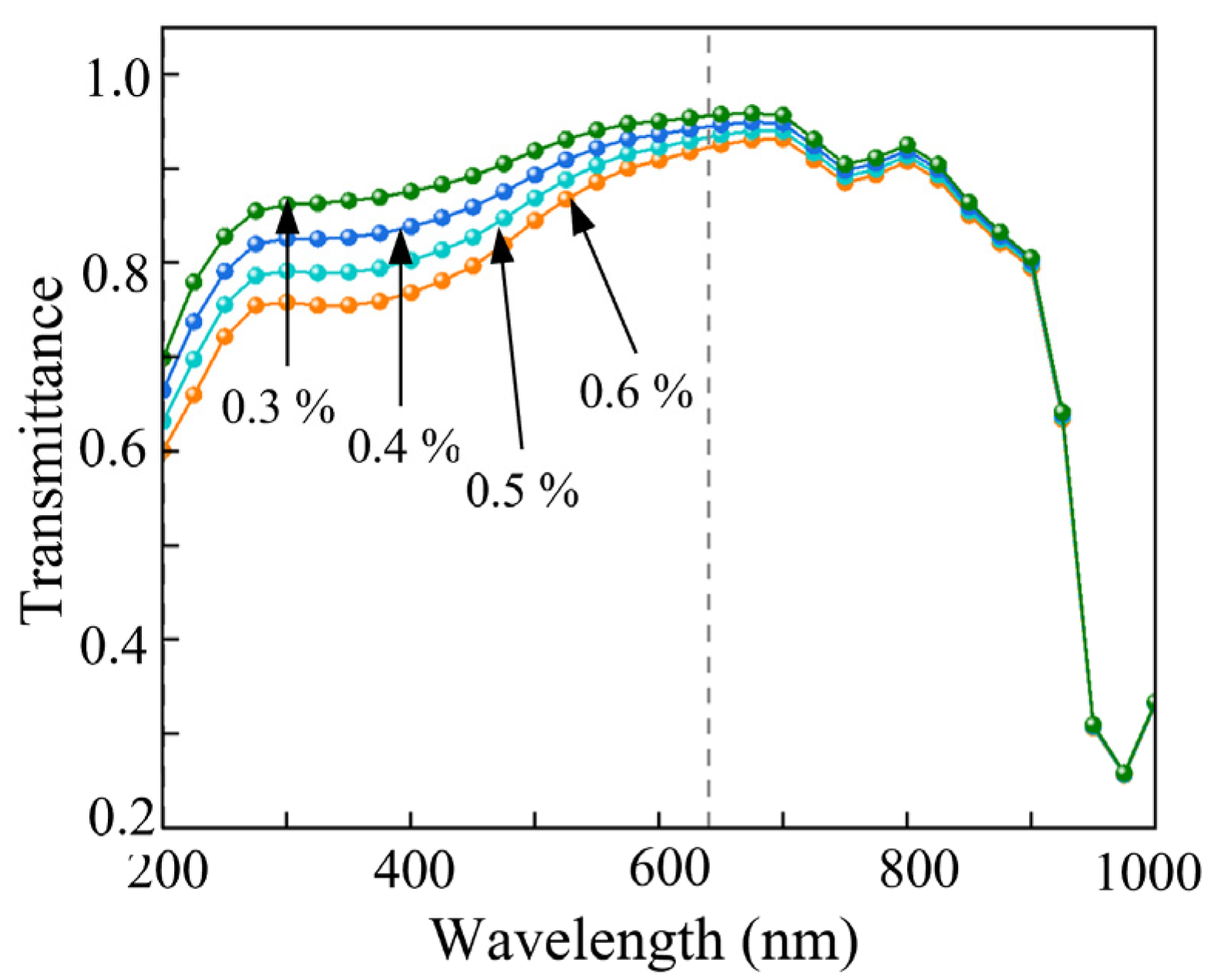
Disclaimer/Publisher’s Note: The statements, opinions and data contained in all publications are solely those of the individual author(s) and contributor(s) and not of MDPI and/or the editor(s). MDPI and/or the editor(s) disclaim responsibility for any injury to people or property resulting from any ideas, methods, instructions or products referred to in the content. |
© 2025 by the authors. Licensee MDPI, Basel, Switzerland. This article is an open access article distributed under the terms and conditions of the Creative Commons Attribution (CC BY) license (https://creativecommons.org/licenses/by/4.0/).
Share and Cite
Wang, G.; Chou, P.; Li, Y.; Xia, L.; Liu, Y.; Wei, G. Solar Spectral Beam Splitting Simulation of Aluminum-Based Nanofluid Compatible with Photovoltaic Cells. Energies 2025, 18, 2460. https://doi.org/10.3390/en18102460
Wang G, Chou P, Li Y, Xia L, Liu Y, Wei G. Solar Spectral Beam Splitting Simulation of Aluminum-Based Nanofluid Compatible with Photovoltaic Cells. Energies. 2025; 18(10):2460. https://doi.org/10.3390/en18102460
Chicago/Turabian StyleWang, Gang, Peng Chou, Yongxiang Li, Longyu Xia, Ye Liu, and Gaosheng Wei. 2025. "Solar Spectral Beam Splitting Simulation of Aluminum-Based Nanofluid Compatible with Photovoltaic Cells" Energies 18, no. 10: 2460. https://doi.org/10.3390/en18102460
APA StyleWang, G., Chou, P., Li, Y., Xia, L., Liu, Y., & Wei, G. (2025). Solar Spectral Beam Splitting Simulation of Aluminum-Based Nanofluid Compatible with Photovoltaic Cells. Energies, 18(10), 2460. https://doi.org/10.3390/en18102460






